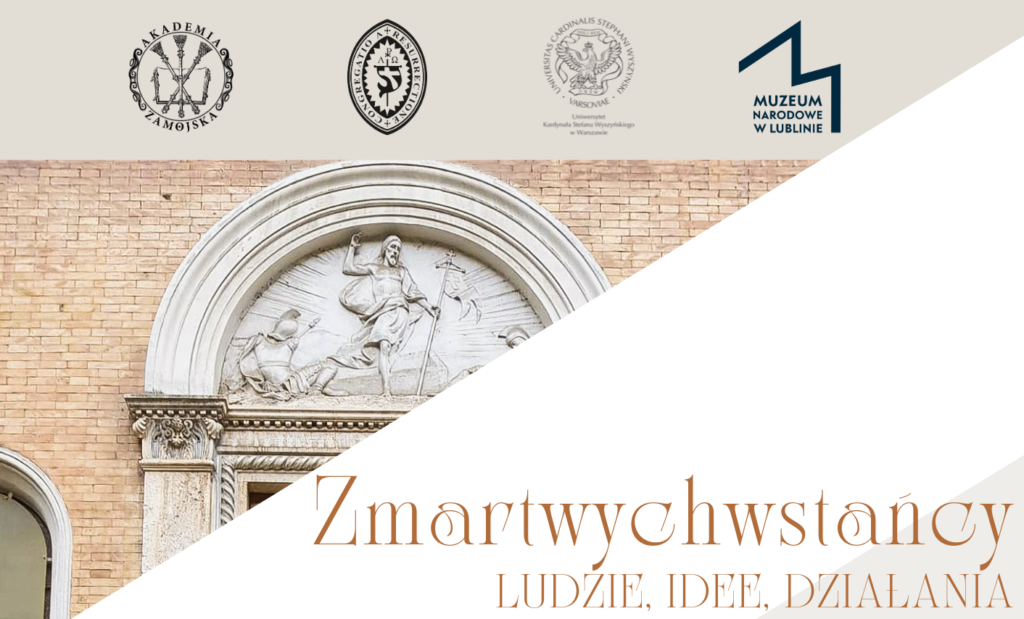Zmartwychwstańcy – ludzie, idee, działania - Conference

What connected the Resurrectionists with prominent Polish poets of the 19th century, such as Adam Mickiewicz and Zygmunt Krasiński? What role did the Congregation play in sustaining the spirit of patriotism and independence ideals during the period when Poland was under partitions? All of this could be learned during the ”Zmartwychwstańcy – ludzie, idee, działania”, which took place on 20 November at the Zamość Town Hall.
The conference aimed to disseminate knowledge about the Congregation of the Resurrection, which had its origins in France in the first half of the 19th century (the order itself was founded in Rome). Bogdan Jański, Piotr Semenenko, and Hieronim Kajsiewicz, considered the founders of the congregation, were the first members of this community and simultaneously active advocates for the Polish cause abroad during the Great Emigration. The Congregation aimed to help compatriots living abroad, as well as Poles in the country, not only in material terms but primarily in the spiritual context.
“This initiative commemorates a group of people who played a significant role in shaping Polish national identity in the 19th century and largely contributed to Poland’s rebirth in 1919. If it were not for the care of the Resurrectionists for the spiritual well-being of many distinguished Poles such as Adam Mickiewicz, Cyprian Norwid, Fryderyk Chopin, and many others, our national elites would undoubtedly be much weaker,” said the Rector of Zamość Academy Paweł Skrzydlewski, PhD.
“The most prominent representatives and founders of the Resurrectionist order were Bogdan Jański, Hieronim Kajsiewicz, and Piotr Semenenko. Another distinguished member of the order was Fr. Walerian Kalinka, a historian and one of the representatives of the Kraków historical school. He contributed significantly to the intellectual development of the order. In addition to patriotic and spiritual activities, the Resurrectionists also engaged in scholarly pursuits. Fr. Walerian Kalinka authored a fundamental work on the Four-Year Sejm, describing the entire course of the Sejm that ultimately led to the adoption of The Constitution of 3 May. Fr. Kalinka also operated in the Hotel Lambert, serving as the secretary to Prince Adam Jerzy Czartoryski, managing emigration correspondence. He also participated in the Crimean War, sending secret dispatches during the January Uprising,” explained Piotr Biliński, PhD from Jagiellonian University.
“This was an assembly established to save patriotic attitudes and society in exile. The situation, after the partitions, the French Revolution, and the Napoleonic era, following unsuccessful uprisings, was very tragic. Hence the idea of creating such an assembly, which originated in Paris and later operated in Rome and on missions, including in the Kingdom of Poland and other partitioned lands, as well as in places like Turkey, where attempts were made to create Polish legions, with Adam Mickiewicz being involved. A close collaborator of the Resurrectionists was also General Władysław Zamoyski, who represented Prince Adam Czartoryski and also took actions to create Polish legions, with the help of the order”, said Dr Piotr Kondraciuk, director of the Institute of Art Market and Culture Management at the Academy of Zamość.
During the conference, presentations were given by, among others: Grzegorz Kucharczyk, PhD, the Jacob of Paradies University (Zygmunt Krasiński and the Resurrectionists. On Polish politics and revolution), Piotr Biliński, PhD, Jagiellonian University (Father Walerian Kalinka. Resurrectionist, historian, emigrant), Dr Beata Skrzydlewska, Cardinal Stefan Wyszyński University, National Museum in Lublin (Fr. Eustachy Skrochowski – precursor of church museology), Dr Maria Nitka, the Eugeniusz Geppert Academy of Art And Design in Wrocław (W.K. Stattler, Adam Mickiewicz, and the Resurrectionists – a meeting of people and ideas).
The conference ”Zmartwychwstańcy – ludzie, idee, działania” took place on 20 November in the Consulatus Hall of the Zamość Town Hall. The organizers were the General House of the Congregation of the Resurrection, the Academy of Zamośc, Cardinal Stefan Wyszyński University in Warsaw, and the National Museum in Lublin.
The event was part of the project “Valorization and Accessibility of Collections from the Time of the Great Emigration and the Establishment of the Congregation of the Resurrection”, financed by the Ministry of Culture and National Heritage of the Republic of Poland.

The conference program:

